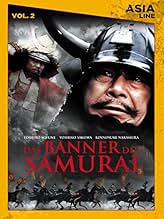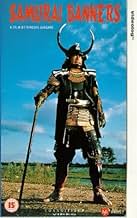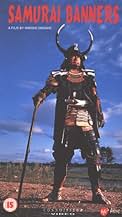A shrewd 16th Century samurai helps a daimyo expand his realm.A shrewd 16th Century samurai helps a daimyo expand his realm.A shrewd 16th Century samurai helps a daimyo expand his realm.
- Director
- Writers
- Stars
Kanzaburô Nakamura
- Katsuyori Takeda
- (as Kankurô Nakamura)
Kôji Nanbara
- Ronin
- (uncredited)
- Director
- Writers
- All cast & crew
- Production, box office & more at IMDbPro
Featured reviews
One of the best samurai epics. "Furinkazan" tells the story of the 16th century warlord Takeda Shingen and his loyal general Yamamoto Kansuke (Mifune Toshiro) embedded in the story of the Takeda clan's rise to power. Outstanding sets, costumes and Sato Masaru's rich soundtrack make the drama highly enjoyable.
Lots of attention to historical detail, like the horned kabuto worn by Yamamoto Kansuke. Climactic battle (4th Kawanakajima)between the Takeda and Uesugi well worth seeing. Story told from the viewpoints of Kansuke and his overlord, Takeda Shingen. I liked this a lot more than the 1990 "Heaven and Hell," which retold the story of the rivalry between Takeda Shingen and Uesugi Kenshin, but from Kenshin's viewpoint. For example, the later movie seemed less accurate and more artsy (each side's soldiers all wore the same standard-color sashimono)in its depiction of the same battle.
After watching Samurai Banners, I was struck with one piece of dialog which sums up the film quite nicely, "In this age of war, survival requires complex conspiracies, secret dealings, and assassinations. They're inevitable." These two lines help describe the atmosphere of 16th century Japan, in which Samurai Banners is set. A Japan divided by warring factions and lords, where treachery and war are the only way of life.
Yamamoto Kansuke (Mifune) is a ronin, who through chance of fate finds himself protecting Lord Takeda's vassal from another Ronin (in a very bloody exchange). Kansuke then moves to the province of Kai, where Lord Takeda awards him a troop of 100 soldiers. Once established Kansuke moves his way up to be Lord Takeda's top military adviser. With Kansuke's help the province of Kai stretches it's grasp to the other provinces through a series of, "complex conspiracies, secret dealings, and assassinations." Samurai Banners is an intricately researched samurai epic. The outfits are incredible, especially Mifune's fearsome black samurai armor which boasts the most incredible helmet I've ever seen. The outfits of the Red Guard are also very impressive and help add to the allure of the film. The set's also match the intensity of the outfits and this film highly succeeds in painting an accurate picture of 16th century Japan.
Mifune is as bad-ass as ever (Of course!) but this time around he sports (besides the crazy armor) a ugly scar, a noticeable limp, and a awesome moustache. In Samurai Banners he plays the "terrifying" Kansuke, a man who is both feared and revered by his troops. In typical Mifune fashion, his one soft spot is for a woman named Pricess Yu. Both the Lord's concubine and an unrequited love interest for Kansuke.
The film itself stays true to the tradition of 60's chambara; a mix of action, romance, war tactics, and character development, which together, helps round out another solid entry for both Mifune and Director Inagaki Hiroshi. The film substitutes most of the battles for the strategies and goings on of the Lord's and his advisor's, although the film has its share of action don't go into this expecting an action packed Chambara flick.
Bottom Line- Good historical war epic with a focus on the people involved more-so than the actual battles. Mifune is a bad as ever!
Yamamoto Kansuke (Mifune) is a ronin, who through chance of fate finds himself protecting Lord Takeda's vassal from another Ronin (in a very bloody exchange). Kansuke then moves to the province of Kai, where Lord Takeda awards him a troop of 100 soldiers. Once established Kansuke moves his way up to be Lord Takeda's top military adviser. With Kansuke's help the province of Kai stretches it's grasp to the other provinces through a series of, "complex conspiracies, secret dealings, and assassinations." Samurai Banners is an intricately researched samurai epic. The outfits are incredible, especially Mifune's fearsome black samurai armor which boasts the most incredible helmet I've ever seen. The outfits of the Red Guard are also very impressive and help add to the allure of the film. The set's also match the intensity of the outfits and this film highly succeeds in painting an accurate picture of 16th century Japan.
Mifune is as bad-ass as ever (Of course!) but this time around he sports (besides the crazy armor) a ugly scar, a noticeable limp, and a awesome moustache. In Samurai Banners he plays the "terrifying" Kansuke, a man who is both feared and revered by his troops. In typical Mifune fashion, his one soft spot is for a woman named Pricess Yu. Both the Lord's concubine and an unrequited love interest for Kansuke.
The film itself stays true to the tradition of 60's chambara; a mix of action, romance, war tactics, and character development, which together, helps round out another solid entry for both Mifune and Director Inagaki Hiroshi. The film substitutes most of the battles for the strategies and goings on of the Lord's and his advisor's, although the film has its share of action don't go into this expecting an action packed Chambara flick.
Bottom Line- Good historical war epic with a focus on the people involved more-so than the actual battles. Mifune is a bad as ever!
Samurai Banners (1969) is Hiroshi Inagaki's, know for The Samurai: Musashi Miyamoto trilogy, crowning achievement-a nearly three hour historically based epic starring Toshiro Mifune as a ronin determined to achieve greatness in his new clan by uniting Japan under one ruler. The story is based on a novel adapted by Shinobu Hashimoto (Rashomon and Seven Samurai) and takes place in the Sengoku warring period 1500-1600. At the time it was the most expensive Japanese film produced with several massive fight scenes that must have been expensive to stage. It immediately calls to mind Akira Kurosawa's two late samurai epic masterpieces Kagemusha and Ran. I wonder why he wasn't involved in the project that was made with his former leading man and the script writer of his greatest triumphs. Nonetheless, Inagaki with cinematographer Kazuo Yamada has created a stylish, colorful, and dynamic film.
A large scale production based on history, this film resembles the later samurai dramas produced for Japanese TV in that a reasonable familiarity with Japanese history would help with the overall understanding of the project.
Mifune plays Kansuke Yamamoto, a ronin with a strong dream of uniting a large part of Japan under one banner. He manages to get hired by a vassal of powerful clan leader Shingen Takeda by betraying a fellow ronin and killing him. Kanasuke quickly rises to the position of main adviser to Takeda as he manipulates Takeda's plans for conquest. The battles go well and along the way Kansuke captures a princess who becomes Takeda's concubine and bears Takeda a son. Kansuke shows a paternal concern for the child and vows to give him a vast realm to lord over.
Inagaki, who was at the tail end of a very long directorial career, creates a detailed recreation of the times especially the armies of the various warring clans. The direction is assured and while old fashioned at times he engages in some very interesting directorial techniques. The photography is very good and the composition of some of the scenes is excellent. All the actors are great although Mifune gets overly theatrical occasionally.
There are hundreds of banners in the film and Kansuke seems to be obsessed with his clan's banner. If this is of historical significance, the film doesn't explain it. The massive battle scenes are vaguely similar to the scenes in Kurosawa's Ran made a number of years later. There's lots of horses and people running to and fro. The actual combat scenes are good but not special.
A very long film at 2 hours and 45 minutes, it managed to hold my interest due to the talent involved but it is an effort to get through. There are a couple of talky scenes and the ending, while possibly accurate, isn't the best. It's as if the film lost it's steam with ten minutes to go. Also the opening set piece with Kansuke betraying the other ronin sets up a dark character that is never really explored again. He's a haunted man obsessed with his dream of unifying Japan but the cold-hearted murderer we are first shown never comes back.
Recommended for samurai films buffs, Mifune fans and people who like long historical dramas. If you are looking for a classic chambara with a simple story and strong quirky characters, this probably isn't the best.
Mifune plays Kansuke Yamamoto, a ronin with a strong dream of uniting a large part of Japan under one banner. He manages to get hired by a vassal of powerful clan leader Shingen Takeda by betraying a fellow ronin and killing him. Kanasuke quickly rises to the position of main adviser to Takeda as he manipulates Takeda's plans for conquest. The battles go well and along the way Kansuke captures a princess who becomes Takeda's concubine and bears Takeda a son. Kansuke shows a paternal concern for the child and vows to give him a vast realm to lord over.
Inagaki, who was at the tail end of a very long directorial career, creates a detailed recreation of the times especially the armies of the various warring clans. The direction is assured and while old fashioned at times he engages in some very interesting directorial techniques. The photography is very good and the composition of some of the scenes is excellent. All the actors are great although Mifune gets overly theatrical occasionally.
There are hundreds of banners in the film and Kansuke seems to be obsessed with his clan's banner. If this is of historical significance, the film doesn't explain it. The massive battle scenes are vaguely similar to the scenes in Kurosawa's Ran made a number of years later. There's lots of horses and people running to and fro. The actual combat scenes are good but not special.
A very long film at 2 hours and 45 minutes, it managed to hold my interest due to the talent involved but it is an effort to get through. There are a couple of talky scenes and the ending, while possibly accurate, isn't the best. It's as if the film lost it's steam with ten minutes to go. Also the opening set piece with Kansuke betraying the other ronin sets up a dark character that is never really explored again. He's a haunted man obsessed with his dream of unifying Japan but the cold-hearted murderer we are first shown never comes back.
Recommended for samurai films buffs, Mifune fans and people who like long historical dramas. If you are looking for a classic chambara with a simple story and strong quirky characters, this probably isn't the best.
Details
- Release date
- Country of origin
- Language
- Also known as
- Samurai Banners
- Production companies
- See more company credits at IMDbPro
- Runtime2 hours 45 minutes
- Sound mix
- Aspect ratio
- 2.35 : 1
Contribute to this page
Suggest an edit or add missing content

Top Gap
By what name was Sous la bannière du samouraï (1969) officially released in India in English?
Answer

























